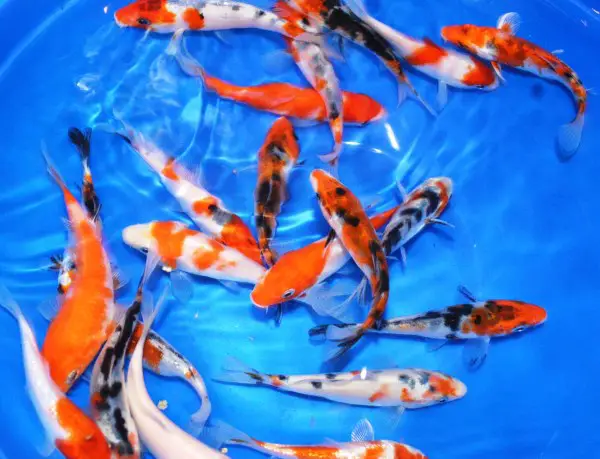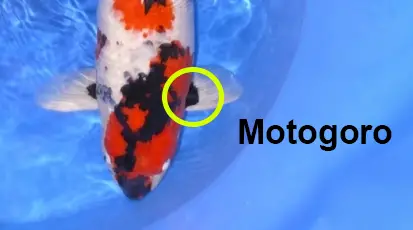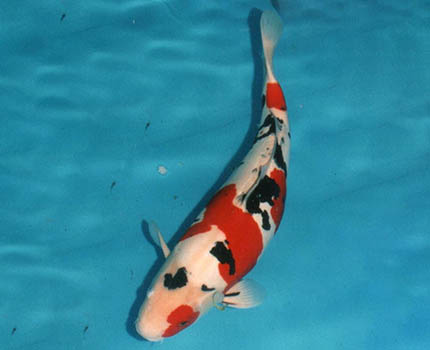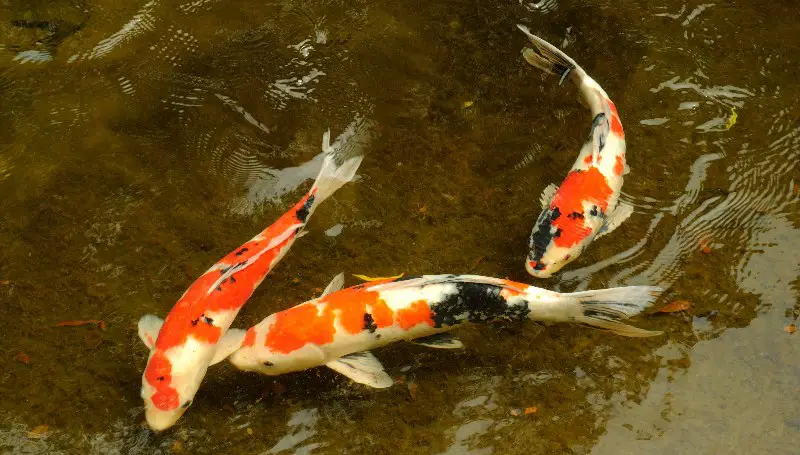This is one of those classic questions newcomers to koi need to know the answer to.
To the layperson, sanke and showa might seem like the same variety of fish. They’re tri-colored koi after all: white, red, and black! And don’t beat yourself up if you’re struggling to tell them apart, even the initiated can find defining the varieties difficult in borderline cases.

CC BY 2.0, https://commons.wikimedia.org/w/index.php?curid=73848516
The fish on the left is a sanke koi, while the center and right fish are showa (although their patterns are not the quintessential examples of showa koi),
You’ll notice as you read this article that I use a lot of words like “usually” and “generally”. That’s because, while there are hard and fast rules, sometimes there are close cases where a particular koi might not seem like a typical showa or a typical sanke, but nonetheless, it is one or the other.
Sanke Is A White Fish And Showa Is A Black Fish!
With sanke, it’s considered that the variety has a white base. While, with showa, it’s considered that the fish has a black base. This is how we conceptualize the color balance difference in these varieties.

By Paulman at English Wikipedia, CC BY-SA 3.0, https://commons.wikimedia.org/w/index.php?curid=46202374
So, generally a showa is going to have more black, versus a sanke, with much less black.
This Isn’t Practical For Identifying Young Koi
This element of the varieties isn’t necessarily an easy tool to help you identify a koi’s variety. This is because black—or sumi in Japanese—tends to “come up” (i.e. it develops) over time. A young showa might not look like a showa because it hasn’t gotten its full complement of sumi yet.
So, therefore, it’s not particularly useful to say that a showa will have more black than white, or red, because that’s not necessarily true.

These are young fish, and while it is possible to identify some of them as showa or sanke already, we must keep in mind that as the fish age more black might develop. There are also some young kohaku (red and white) koi in this group.
Although, the converse is generally true, a sanke should have significantly more white than black. But, again, because of the issue of black color development in koi it’s challenging to use this as an identification tool for younger fish.
Showa And Sanke, A Practical Explanation
Okay, so far I haven’t exactly but the topic to bed. So, let’s get into some practical examples to help you gain the confidence you need to recognize the difference between sanke and showa koi.
Sumi In Sanke Vs. Showa, Simplified
Sanke will have small patches of black color that work to accent the larger red steps along the fish’s back. Whereas, showa will have large, striking patches of black that feel quite dominant in the pattern.

Notice that the black on this fish occurs in smaller patches and is not on the head. This koi is a sanke.
Below The Lateral Line?
The lateral line in fish is a long row of sensor organs that run along the animal’s flank. It is visible on koi and looks like a long row of small divots.
When identifying whether a koi is a showa or a sanke you can look to see if there is black below the lateral line. If the black goes below the lateral line, then this is indicative that the fish is a showa.
Red is a little bit different; it can sometimes cross the lateral line in a sanke, but generally isn’t preferred to. Whereas, with a showa, the pattern has an overall “wrapping” quality that goes around the fish.
Conversely, black below the lateral line in a sanke is not common or desirable.
Black On The Head?
A good indicator is the color on the fish’s head!
A sanke only has two colors on the head: red and white. And the white should be predominant, because in a sanke it’s the base color and the beni (red) patches should begin on that white base.
Whereas, a showa stands out because typically it does have black on the head, and black is considered the base color. But, with showa, it’s more than that: there should also be red on the face.
Black On The Fins?
Sanke are usually going to have white fins, the same white found on their body. Having said that, if there are black stripes along the rays of the pectoral fins of a sanke, it isn’t the end of the world. In fact, it isn’t even really undesirable.
However, black on the fins of a showa is much more common. It even has a special word used to describe a patch of strong black pigment extending from the oint of the body and fin: motogoro!

https://commons.wikimedia.org/w/index.php?curid=46202374
Showa koi with motogoro markings on the body to fin joint.
Remember though, motogoro is not always present on a showa.
Doitsu And Gin Rin
Scaleless (i.e. doitsu) varieties of both sanke and showa are available. I wrote an article on the origin of doitsu koi here.

Here is a doitsu showa. Notice the scaleless body and, as a consequence, the super clean lines along the edges of the black and red.
Another scale type, gin rin, is also possible in show and sanke koi.
Don’t Forget: Gosanke And Kohaku!
And I feel bad not referencing kohaku—the red and white koi.

Kohaku are the third member of the “big three” koi varieties. Kohaku, sanke, and showa are known as the “gosanke” varieties. I’ve written an article on the meaning behind the word “gosanke”. Check it out here.
Check out this link to see all my articles about koi.
For excellent koi content, check out Shawn McHenry’s informative videos with ThePondDigger on YouTube.
Header Image Credit
By Daniel Ramirez from Honolulu, USA – Koi at Japanese Garden – UH Manoa, CC BY 2.0,
https://commons.wikimedia.org/w/index.php?curid=73848516



